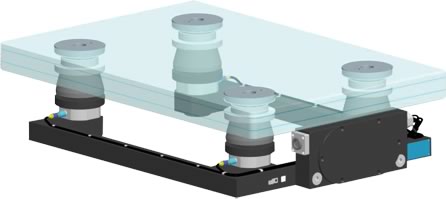Force Plates and Pressure Plates
Interacting with the ground and applying the correct forces is integral to creating a good golf swing. There are two general technologies for measuring the forces applied to the ground: force plates and pressure plates.
Force Plates:

A typical force plate will have a force sensor near each corner of the plate. Each force sensor contains three separate components that independently measure the vertical, anterior-posterior (front to back), and lateral (side to side) forces.
Single Force Plate
If a single force plate is used, it tells us the following things about the golfer:
- how much force the golfer applied to the ground in each direction
- where the vertical force was applied (specifically the average location)
- the total moment (or ‘twisting force’)
Two Force Plates
If two plates are used, we get even more information. Not only does a two-plate system tell us all of the information that a single plate does, it also tells us how much came from the right leg and the left leg.
Limitations of force plates:
- Force plates are typically designed to be permanently mounted in a floor so they are flush with the floor surface. Portable plates are available, but they tend to be somewhat heavier than pressure plates, and can take longer to set up after moving.
- While they typically give more information than a pressure plate, they do not – on their own – tell us where the feet or the body is. To know this information, a 3D system or video camera must be used in conjunction to show where the forces are relative to the golfer’s body.
Pressure Plates:
Pressure plates, or mats, are made up of a grid of small pressure sensors, usually covered with a surface appropriate for golf shoes. Typical sensors are ¼ or ½ inch square. Each of the sensors in the mats record the amount of pressure being applied vertically. Pressure mats for golf use tend to be very portable. They can typically be laid down on any surface that is relatively firm and flat, and setup time is quick. Pressure mats can tell us the amount of pressure under all areas of the foot (depending on the size of the sensors), providing a ‘map’ of the pressure distribution.

Pressure mats can, like force plates, combine the pressure data to tell us the center of pressure under each foot, and the location of the combined center of pressure for the whole body. Pressure mats typically report more information about the path of the individual foot centers of pressure and the combined center of pressure than force plates.
Limitations of pressure plates:
- Pressure plates do not measure horizontal forces (or pressures) in any way.
- Pressure mats can use the pattern of pressure to show where each foot is for the golfer, so no other equipment is needed if the user only wants to know the location of the feet. However, if the user wants information about where the body is, or where the club is, including knowing timing of swing events, then some kind of optical or video system must be used.
- The collection speed for pressure mats tends to be much lower. While force plates can run at extremely high rates (5,000 samples per second or more), the commercially available pressure plates typically offer between 20 to 100 samples per second.
- While more and more people are learning about the use of force and pressure plates in golf instruction, pressure plates are often mistakenly called force plates. The easy way to tell the difference is whether any information about horizontal forces are being presented. If only vertical pressure (or force) is being reported, it is probably a pressure mat system.
In the Golf Teaching and Research Center, we use two force plates permanently mounted in the floor.